Russia Imperial Eggs Gift - Юрий Степанченко
 Most of the Imperial Faberge eggs were created for the Russian Imperial Court by Carl Faberge . Nowadays, the amazing and legendary works of Imperial Egg are even more famous than a century ago, when they were created, and are considered to be the symbols of love and faithfulness. Choose your unique piece from the widest choice of Imperial Egg replicas in our inventory. Imperial Eggs
Most of the Imperial Faberge eggs were created for the Russian Imperial Court by Carl Faberge . Nowadays, the amazing and legendary works of Imperial Egg are even more famous than a century ago, when they were created, and are considered to be the symbols of love and faithfulness. Choose your unique piece from the widest choice of Imperial Egg replicas in our inventory. Imperial Eggs
А Imperial Egg is, perhaps, one of the most beautiful and exquisite objects ever created in Russia. Moreover, this example of extraordinarily extravagant and absolutely exquisite fine jewelry making is a symbol of the opulence and extraordinary wealth the Russian Imperial Family wielded at its zenith.
The House of Faberge was also given the title of official imperial jewelers of the Royal Family, as they proceeded to fund the cost of all the future eggs. While Carl Faberge was given completely free reign in how he was going to produce the eggs, the Imperial Family demanded that each egg should contain some kind of surprise. Each year, Nicholas II commissioned two Imperial Faberge Eggs to be made, one for his wife and one for his mother. Though a mere two eggs were commissioned, entire legions of craftsmen and artists dedicated their talents to crafting the finest jeweled eggs imaginable. For example, one of the Eggs opened up to reveal a yolk, inside which nested a golden hen with ruby eyes. Subsequently, opening up the hen, a mini diamond crown and a tiny ruby egg could be discovered! Sadly, World War I and the Bolshevik Revolution brought Russia to its knees, and cut short the lifespan of the Imperial Faberge Egg culture.
Currently, there are only 42 Faberge Eggs in existence. These eggs have been hunted down by collectors, fetching astronomical prices at auctions. In fact, the last Faberge Egg sold, brought in a price of £8.9 million at Christie’s in 2007. Many of the other Faberge Eggs have forever been lost to the sand dunes of time, history, and war. However, the tradition of the magnificent Imperial Egg is kept alive in the present day by modern firms and Saint-Petersburg Global Trade House is proud to present the best specimens to its customers.
Faberge Eggs are some of the most exquisite objects ever created. These world-famous works of art are inextricably linked to the Russian history.
The idea for the Imperial eggs came about in the 18th century. Back when Easter was the most important event for the Russian Orthodox Church, people would take hand-painted eggs to church, have them blessed, and then hand them out to their loved ones. In 1885 the very first Imperial Egg was created on a special order from the Russian Emperor Alexander III. The Emperor needed an exceptional gift for his wife Maria Feodorovna and placed an order with the goldsmith and jeweler Peter Carl Fabergé, whose beautiful creations caught Maria's eye at an exhibition in 1882.
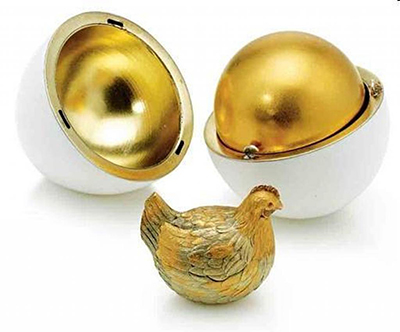
The Hen Egg by Carl Faberge, 1885
On Easter morning, Fabergé delivered the first Imperial egg to the palace. The beautifully simple enameled egg opened up to reveal the first surprise – a yellow gold "yolk." The yolk, in turn, contained an enameled chased gold hen. And inside the hen were two tiny gifts: a diamond miniature of the royal crown, and a tiny ruby egg pendant that could be hung on a necklace – both now lost to history. Maria Feodorovna was absolutely stunned and delighted with the gift.
The Emperor Alexander III was so pleased by her reaction that he named Fabergé the official jeweler to the imperial family and subsequently presented Maria with a new egg every year thereafter. Their son, Emperor Nicholas II, continued the tradition, giving a precious egg to both his mother and his wife, Empress Alexandra Feodorovna, every Easter. Carl Fabergé was given the complete artistic freedom with only one requirement: each egg must be unique, and each must contain a suitable surprise for the Empress. Between 1885 and 1916, Fabergé created fifty egg-shaped Easter gifts for the royal family.
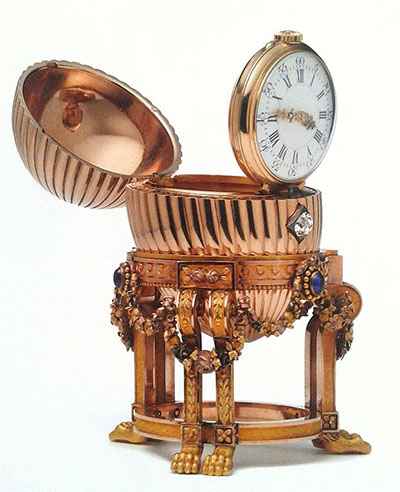
The Third Imperial Egg by Carl Faberge, 1887
Given by Emperor Alexander III to Empress Maria Feodorovna for Easter of 1887, this Imperial Egg contained a surprise of a lady’s watch, with a white enamel dial and openwork diamond-set gold hands. The jeweled and ridged yellow gold Egg was encircled by colored gold garlands, suspended from cabochon blue sapphires, topped with rose diamond set bows. The original tripod pedestal has chased lion paw feet.
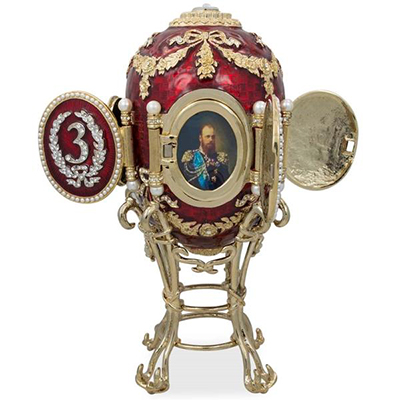
Caucasus Egg by Carl Faberge, 1893
Caucasus egg was created by the House of Carl Fabergé from gold, silver, ruby, enamel, diamonds, platinum, ivory, pearls, and rock crystals. The Imperial Egg has four oval "windows", each of which is closed by an oval door with a border of pearls. In the center of each door there is a diamond wreath supporting a number, a component of the number 1893. Behind each opening door there is a miniature on an ivory, representing the Abastumansky palace inthe Caucasus, where George, Emperor's and Empress' first son, spent most of his life.
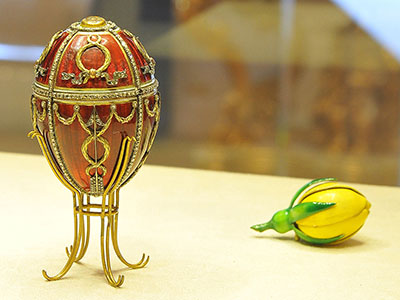
Rosebud Egg by Carl Faberge, 1895
The Rosebud Egg of 1895 was the first of the series presented by Emperor Nicholas II to his wife, Empress Alexandra Feodorovna, a few months after their marriage. The Imperial Egg is covered by transparent red enamel and lines of diamonds. At its apex the egg has a miniature portrait of the young Emperor under a table-cut diamond, and at its base the date 1894.The egg opens to reveal a hinged yellow rosebud, another symbol of the couple's love for one another. The bud, in turn, originally contained two tiny surprises, a miniature replica of the Imperial crown, representing Alexandra's new life as the Empress of Russia, and a ruby Egg pendant hanging within it.
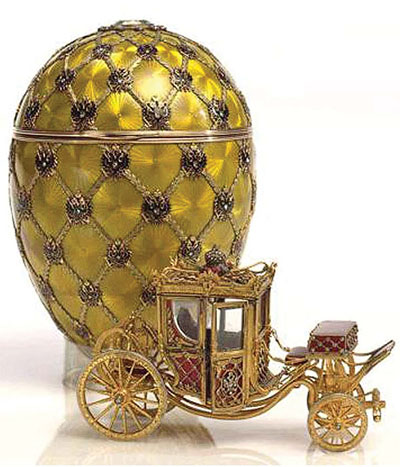
Coronation Egg by Carl Faberge, 1897
Probably the most iconic and recognized of the creations of the House of Fabergé, this Coronation Egg was presented by Emperor Nicholas II to his wife Alexandra Feodorovna. Its outer shell is made of multi-colored gold, embellished with translucent yellow enamel and black enamel double-headed eagles, set with diamonds. The Egg opens to reveal a removable miniature replica of the Imperial coach, used by Alexandra Feodorovna on her entry into Moscow for her coronation at the Uspensky Cathedral the year before.
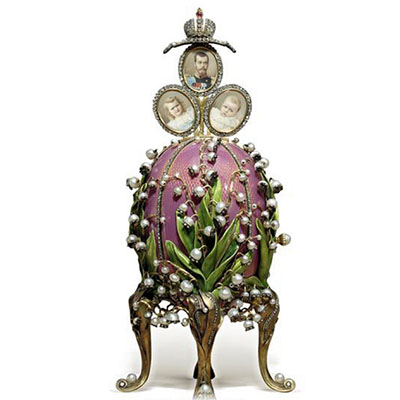
Lilies of the Valley Egg by Carl Faberge, 1898
The Lilies of the Valley Egg, an 1898 gift from Nicholas II to Empress Alexandra Feodorovna, is one of only two eggs executed in the Art Nouveau style. Fabergé knew that pink was Empress' favorite color, and lilies of the valley were her favorite flowers. This golden egg stands on four cabriolet feet entwined with diamond-set foliage and is covered with pale pink enamel and a multitude of pearl- and diamond-set lilies of the valley sprays. A pearl knob, when twisted, reveals this egg's surprise: portraits of Nicholas II and his two oldest daughters, Olga and Tatiana, framed in rose diamonds.
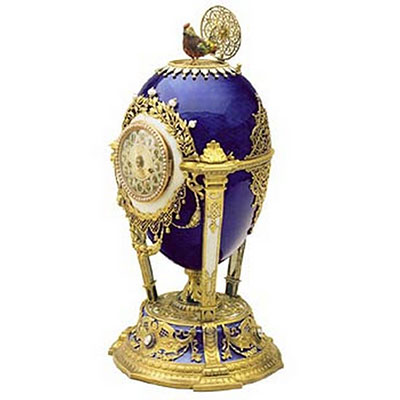
Cockerel Egg by Carl Faberge, 1900
The 1900 Cockerel Clock Egg (previously known as Cuckoo Clock Egg) was given by Nicholas II to Maria Fyodorovna on Easter of 1900. The Cuckoo Egg is Fabergé's rendition of an eighteenth and nineteenth century singing bird clocks. Made of gold, diamonds, rubies, pearls, and transparent purple and opaque white enamel, the egg is supported by three slender pilasters and features enameled dial with the diamond-set Arabic numerals. At the stroke of the hour, a ruby-eyed rooster emerges crowing and flapping its wings from the top of the elaborately designed Imperial Egg.x

 Imperial Eggs
Imperial Eggs
Comments
Post a Comment